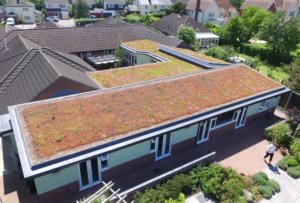 Nick Day, managing director of green roof specialists Optigreen, discusses the importance of selecting the right products when implementing a green roof system…
Nick Day, managing director of green roof specialists Optigreen, discusses the importance of selecting the right products when implementing a green roof system…
Green roofs are all the while becoming more commonplace as part of a building specification and are providing many benefits including water attenuation properties and increased biodiversity. At the same time the requirements of specifiers when it comes to roof greening are increasingly varied and complex and it is important than ever to be selecting the right products and systems.
When it comes to product selection, as in many areas of construction, there is no “one size fits all” where green roofs are concerned. Let’s examine one or two different areas of the green roof build-up where the wrong product selection can cause potential issues.
Drainage Layers
Every vegetated green roof needs to be able to drain correctly and also needs to be able to retain water within its build-up for use during extended dry periods. Poor drainage provision, for example, can risk waterlogging of the substrate layer with consequent root damage and potential failure of the vegetation. A good green roof system will provide this at different layers within the roof make up, one of which is the drainage layer.
The drainage layer on a vegetated green roof will typically consist of a protection fleece, drainage board and filter layer. With regard to the drainage board element there are shallow boards on the market, typically ranging from 6 to 12mm in depth, which are designed purely for drainage purposes under hard landscaping or civil construction but that will not provide the required drainage performance or reservoir feature needed for a vegetated green roof. Whilst the cheaper price of this type of board may initially be attractive in this application it is likely to prove a false economy in the longer term. A reservoir or “cuspated” board is best for this application which provides individual chambers to store water and also, through its design, a clear drainage path underneath. Most reputable green roof material manufacturers and suppliers will have different depth boards, typically ranging from 20mm to 60mm depth, available so that the level of water storage and drainage capacity can be optimised both in terms of performance and cost relative to the type of planting and roof usage involved.
Pitched Roofs
Pitched green roofs are being specified in ever greater numbers and these present their own set of requirements when it comes to product selection. The general rule here is that its best not to improvise but instead to use a system designed for the purpose.
I once surveyed a 20 degree-pitch green roof where a makeshift anti-slip arrangement had been used with horizontal sections of aluminium edge trim fixed through the waterproofing membrane. The substrate had subsequently become fully saturated, the aluminium had buckled under the weight and the green roof build-up had slipped towards the base of the slope. The waterproofing membrane had also been damaged in the process. This was a costly mistake and one that could have been avoided if the correct anti-slip system had been selected at the outset.
When it comes to green roofs a “pitched roof” is normally considered to be one that has a pitch of 5 degrees or more. Beyond this pitch the normal drainage board for flat roofs, mentioned before, won’t work as the water will want to drain to the lowest point. However, your green roof supplier may have an alternative drainage and reservoir board specifically designed for use on a pitched roof. Additionally beyond 10 to 15 degrees pitch an anti-slip measure will also be required.
For pitched green roofs a range of solutions is necessary depending on the pitch of the roof, configuration ( i.e is it a mono pitch or duo pitch roof), the detail at the base of the slope and slope length. Here an engineered solution is required to provide a bespoke specification suited to the individual project.
Blue Roofs
The contribution that green roofs can make to storm water management on a building is already widely understood. However, engineers are increasingly looking for greater water attenuation and blue roofs are becoming more common. A blue roof is, basically, designed to store a larger amount of rainwater for a given period of time and then release it slowly into the local surface water drainage system using the benefits of a green roof build-up alongside a large capacity storage board and an a calibrated outlet restrictor. It is worth mentioning that a blue roof can sometimes involve a hard landscaped surface. Correct product selection is vital here as is the ability of your supplier to be able to provide storage and drainage calculations and the correct system to suit individual project requirements.
Technical Support
Finally, it may seem obvious but make use of the technical services that your green roof supplier provides. They should be able to provide a bespoke specification for your project which should include technical data for the products included. If you are a contractor tendering for a green roof this is particularly important as the specification that came with enquiry may have been cut and pasted from a previous project and be entirely unsuitable for the project in hand. There is also useful independent advice available from GRO (The Green Roof Organisation) who are affiliated to the NFRC and who have produced the The Green Roof Code which is full of useful information and design guidance for green roofs. You can download a free copy at www.nfrc.co.uk

